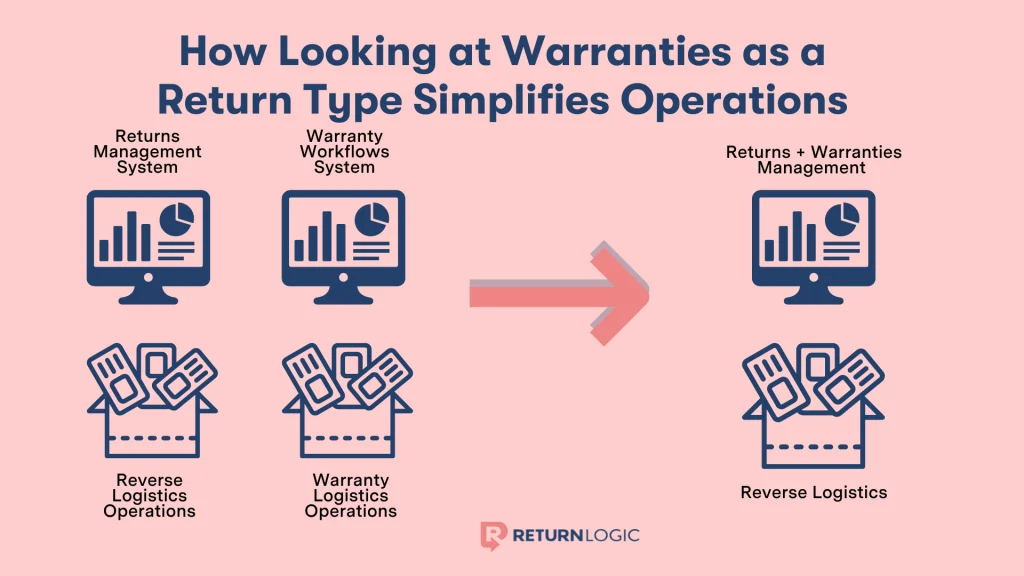This is Why You Should Consider Warranty Requests as a Return Type

When a customer makes a warranty request, a return policy is nothing if the promises made can’t be backed up.
Warranties prove to your customers that you believe in the quality of your products.
But having an efficient workflow that ensures each warranty request is processed seamlessly is essential for a warranty program to hold any value.
Up until now, warranty requests have been considered separate from returns. But this segregation can cost ecommerce retailers thousands of dollars.
We’ve been gathering data on the ecommerce warranty industry since 2018, and one conclusion is very clear: Retailers who want to optimize their warranty workflows should categorize warranty requests as a return type.
This article breaks down how a simple change in definition can significantly impact business strategies for ecommerce retailers.
Why Warranty Requests are Traditionally Separated from Other Return Types
Currently, ecommerce merchants categorize post-purchase behavior based on the customer’s intention.
Because of this, warranties and other return types have traditionally been separated.
When a customer puts in a warranty request, they don’t actually want to return the product. They just want their issue with it fixed – as opposed to other return types (refunds, exchanges, store credit), where the customer’s intention is to give back the product because they are unsatisfied with it.
While the customer may not actually want to get rid of the product, handling a warranty request looks very similar to handling other return requests in that both:
- Indicate something wrong with the product.
- Require getting information from the customer about the original purchase, and
- Need a system for reverse logistics in place (funneling the products backward through the supply chain).
These similarities are important because it shows that although the customer may approach warranty requests differently from other returns, the process looks more or less the same for the retailer.
Simply put, their reasons may be different, but their solutions are the same.
So, having a separate process for just warranties is really doubling the work for your team. Let’s take a look at how.

Why Separating Your Warranty Workflow is Inefficient
Putting warranty requests in a category separate from other return types forces you to form two separate workflows and double your work.
On the one hand, you’ll have a single solution for exchanges, refunds, and store credit.
You’ll have to create a system for returns management to handle communications between teams and your customers. You’ll also want to have a way to collect all of the returns data in order to analyze and improve product performance.
Once you have a way of gathering information, you’ll also want to have a system of reverse logistics. How are the actual products going to get back to you, the retailer?
This sounds like a lot of work, right?
This means after all of that, you’ll still have to come up with a way to communicate with your customers that are trying to process a warranty request, how you’re going to collect the data from those warranty requests, and a system for products to flow back and forth through the supply chain.
As a result, you end up with:
- 1 system for returns management to handle communications and data for all returns.
- 1 system for warranty workflows to handle communication and data for all warranties.
- 1 system of reverse logistics to manage returned products moving back up the supply chain.
- 1 system of reverse logistics to manage warranty products moving up and down the supply chain.
By putting warranty requests in their own category, you’re quite literally doubling the work and cost for your business.
Categorizing warranties with other return types will simplify your solutions significantly.

How Warranty Requests as a Return Type Affect Customer Behavior
The exponential growth of ecommerce retail has made one thing clear: returns are a part of the shopping experience that’s here to stay and only getting bigger.
This is important to understand as an ecommerce merchant because it shifts the way you should approach returns altogether.
The business goal goes from limiting the number of returns received to optimizing returns to increase the bottom line.
Well, including warranty requests as a return option for your customers does just that. And we have the numbers to prove it.
Warranty Returns Limit Refunds
Some returns management software companies push exchanges as a way to limit refunds and keep sales, which intuitively makes sense.
But we’ve found that 60% of customers will ask for a refund on average, whether or not exchanges are also given as an option.
However, when warranties are also offered as a return type to customers, processed refunds drop by 10%.

Image Source: ReturnLogic Internal Data

Image Source: ReturnLogic Internal Data
To understand why that is, you have to put yourself in the shoes of your customer.
A return is always an indication that the customer is unsatisfied with the product they purchased.
While an exchange offers the customers a replacement, more times than not, they’d rather just return the product like it never happened than risk getting a new one with the same issue.
Offering a warranty return recognizes the fact that something about the product is unsatisfactory to the customer and gives you, the retailer, the chance to fix that problem.
So, not only does offering a warranty return keep the products in the hands of your customers, but it also makes your customers feel heard, which will ultimately deepen your relationship with them.
Warranty Requests are Exponentially Increasing
Not only does offering warranties as a return type decrease refunds, but increasingly more customers are asking to process a warranty when it’s offered as a return type.
Since 2018, we’ve processed 500,000 warranty return requests.
Additionally, the number of warranty requests per quarter has increased by 2000%, clearly showing that customers are getting more excited about warranty returns.

Image Source: ReturnLogic Internal Data
These numbers showcase that offering warranty requests as a return type makes a huge impact on customers’ returns behavior.
It also gives us some insight on the customer experience: If given the chance, people would rather get their product fixed than send it back.
This ultimately increases your bottom line because:
- You’re not sending money back on a returned sale.
- You’re improving customer satisfaction and loyalty.
- You’re keeping your customers coming back for more.
In the end, not only are you keeping money in your pocket, but you’re not losing out on future customer lifetime value for customers who would’ve otherwise churned.
Conclusion
Warranty programs show your customers that you stand by your products. But a program is only as good as how well the retailer is at managing it.
Categorizing warranty requests with other return types helps you to create the most efficient system for managing warranty requests because it stops you from doubling your processes.
However, the benefits of considering warranties as a return type go beyond that.
Offering warranties as a return type has proven to affect customer behavior by dropping refunds by 10%, showing that customers want to keep their purchases if they’re given the chance to get their problem solved.
Categorizing warranties as a return type may seem like a meaningless change, but this simple shift in definition can completely change the way you run your business.


